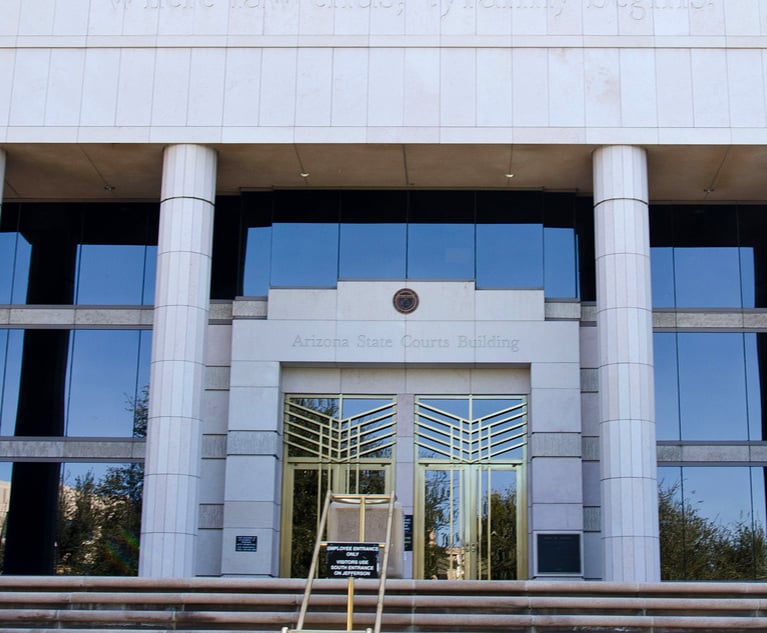Merger mechanics
Over the past five years there have been significant developments within the legal services sector in the major global offshore jurisdictions, in particular the creation of multi-jurisdictional offshore law firms representing a dramatic change from the traditional offshore law firm model.
July 25, 2007 at 08:09 PM
7 minute read
Over the past five years there have been significant developments within the legal services sector in the major global offshore jurisdictions, in particular the creation of multi-jurisdictional offshore law firms representing a dramatic change from the traditional offshore law firm model.
This model depended on clients choosing the jurisdiction first and the firm second. Under the multi-jurisdictional model, firms operate in several locations and attract business there by the quality of service delivered globally.
The rationale for expanding Appleby outside its original Bermuda base was our clear understanding that clients could choose from a variety of jurisdictions and, by not offering them products and services in the key locations, we could not grow with our clients.
While some of our clients expressed clear interest in the multi-jurisdictional model, others had some reservations. However, once we fully introduced the model, client acceptance has been very high, with our clients appreciating the benefits of using a firm located in multiple jurisdictions.
Target markets
International growth can be achieved either by opening new offices, or by mergers. We realised that in more sophisticated markets with small numbers of well-established firms holding the majority of the market share, penetration is tougher than in wider markets with less differentiation.
For us, therefore, the Cayman Islands and Jersey were clearly merger markets. From the perspective of the legacy firms in those locations with whom we merged, they realised that combining with an international firm would result in added resources and increased market position. For us, acquiring well-established local firms enabled us to take advantage of existing relationships and brand, while building our reputation in the local market.
In other jurisdictions such as the British Virgin Islands and Mauritius, Appleby decided to open a greenfield site. Continuing investment will ensure that the local offices become substantial players in their respective jurisdictions and significant assets to the firm.
Increasing competition in the offshore sector made it imperative for us to have a credible presence in these key markets at an early date.
All our mergers have been 'true' mergers – meaning that partners in the combined firms became equity participants in the global whole.
Conversely, a number of our competitors have structured their mergers as acquisitions, with the local firm disappearing in the larger group. It is our belief that by acquiring partners with equal commitment, we create a powerful internal impetus to succeed.
Transactions
In our first merger, our primary focus was on the mechanics of the transaction. The process of integration was understood to be necessary, and although some effort was made prior to confirmation, the bulk of the integration took place after completion. In the case of our support areas, with the exception of marketing where co-ordination was critical prior to announcement, the staff at each legacy firm only began contact with their counterparts post-merger.
By our second transaction, more emphasis was placed on integration. A detailed plan was put in place in advance of the merger date and contact between administrative departments at both firms was encouraged from the outset.
The internal announcement was also co-ordinated carefully in all departments, ensuring that once all staff were briefed, there was surprise but no undue concern.
The regular day-to-day management of an offshore law firm presents a number of challenges not generally experienced by onshore firms. In keeping with our multi-jurisdictional focus we have explicitly not designated a 'head office' and do not wish to be seen to be based in any one particular jurisdiction. Similarly, we are decentralising all support services to fee earners, including compliance, information technology, knowledge management, human resources, marketing and finance, as our directors serve in different offices and build global teams.
Challenges faced
One challenge of operating in the offshore environment is the limited choice of service providers – for example, telecommunications facilities and their costs will be high compared with onshore centres, while the pool of skilled personnel is generally smaller. Telecommunications also affects our ability to provide worldwide solutions for email, document management and financial systems which have to be robust to ensure the firm is able to process information with rapid response times.
Recruitment in offshore jurisdictions also presents issues. Immigration rules in all our jurisdictions require that employers give every opportunity
to local citizens to qualify and find employment, and the firm actively seeks to promote this by sponsoring scholarships, educational awards and training programmes.
However, there is a lack of qualifying lawyers in all locations; therefore we typically recruit abroad (because of their common law status) from the UK, Canada, Australia, New Zealand, South Africa and Hong Kong, although numerous nationalities are represented in the firm.
Immigration procedures are cumbersome and time-consuming and, as it is exceedingly difficult to respond to changes in client demand by promptly hiring lawyers, some degree of 'over-hiring' is inevitable to try to anticipate demand and ensure that client service is maintained.
Cultural compatibility is a challenge in any merger, but even more so in the offshore world. Our staff in all jurisdictions are a blend of local and international lawyers. This mix ensures the creation of a positive and stimulating environment, thus actually making the creation of a global culture easier between the jurisdictions. Due to our skill in integrating individuals from a variety of backgrounds, integrating offices has been less of an issue.
The most complex area in a merger consists of managing the aspirations of lawyers, particularly those from smaller legacy firms, and the need to address the possible staff uncertainty. Individuals are concerned about the security of their position, their opportunities for advancement and changes to reporting lines. It is imperative to recognise these real concerns and ensure a clear understanding that opportunities for advancement will continue based on merit and not location or national origin. As long as the firm lives up to that commitment, these fears subside. Naturally, not everybody will be happy and there will inevitably be some losses.
Mergers require a considerable commitment in time and money. However, the return on this investment is huge and, in my opinion, it is entirely a question of the energy employed in undertaking the exercise that ultimately determines the outcome. Creating a meaningful presence on the ground in a new location, with credible, well-respected professionals and a base that pays for itself, gives a substantial lift to the expansion strategy.
While organically-grown offices have the advantage of being more homogenous, and more immediately tied to the 'home' location that created them as a 'colony', the reduction in stress and commitment required is matched by the fact that these offices tend to take longer to become a substantial presence and to generate the revenue of a mature office.
A merger is not the path for every firm and it most certainly is not the path in every situation. Given the tremendous management energy and commitment across the firm that is required, merger plans should be employed judiciously, as part of the growth strategy of any international offshore firm.
Peter Bubenzer is the global managing partner of Appleby.This content has been archived. It is available through our partners, LexisNexis® and Bloomberg Law.
To view this content, please continue to their sites.
Not a Lexis Subscriber?
Subscribe Now
Not a Bloomberg Law Subscriber?
Subscribe Now
NOT FOR REPRINT
© 2025 ALM Global, LLC, All Rights Reserved. Request academic re-use from www.copyright.com. All other uses, submit a request to [email protected]. For more information visit Asset & Logo Licensing.
You Might Like
View All

Some Elite Law Firms Are Growing Equity Partner Ranks Faster Than Others
4 minute read
KPMG's Bid To Practice Law in US On Hold As Arizona Court Exercises Caution
Trending Stories
- 1Public Notices/Calendars
- 2Wednesday Newspaper
- 3Decision of the Day: Qui Tam Relators Do Not Plausibly Claim Firm Avoided Tax Obligations Through Visa Applications, Circuit Finds
- 4Judicial Ethics Opinion 24-116
- 5Big Law Firms Sheppard Mullin, Morgan Lewis and Baker Botts Add Partners in Houston
Who Got The Work
J. Brugh Lower of Gibbons has entered an appearance for industrial equipment supplier Devco Corporation in a pending trademark infringement lawsuit. The suit, accusing the defendant of selling knock-off Graco products, was filed Dec. 18 in New Jersey District Court by Rivkin Radler on behalf of Graco Inc. and Graco Minnesota. The case, assigned to U.S. District Judge Zahid N. Quraishi, is 3:24-cv-11294, Graco Inc. et al v. Devco Corporation.
Who Got The Work
Rebecca Maller-Stein and Kent A. Yalowitz of Arnold & Porter Kaye Scholer have entered their appearances for Hanaco Venture Capital and its executives, Lior Prosor and David Frankel, in a pending securities lawsuit. The action, filed on Dec. 24 in New York Southern District Court by Zell, Aron & Co. on behalf of Goldeneye Advisors, accuses the defendants of negligently and fraudulently managing the plaintiff's $1 million investment. The case, assigned to U.S. District Judge Vernon S. Broderick, is 1:24-cv-09918, Goldeneye Advisors, LLC v. Hanaco Venture Capital, Ltd. et al.
Who Got The Work
Attorneys from A&O Shearman has stepped in as defense counsel for Toronto-Dominion Bank and other defendants in a pending securities class action. The suit, filed Dec. 11 in New York Southern District Court by Bleichmar Fonti & Auld, accuses the defendants of concealing the bank's 'pervasive' deficiencies in regards to its compliance with the Bank Secrecy Act and the quality of its anti-money laundering controls. The case, assigned to U.S. District Judge Arun Subramanian, is 1:24-cv-09445, Gonzalez v. The Toronto-Dominion Bank et al.
Who Got The Work
Crown Castle International, a Pennsylvania company providing shared communications infrastructure, has turned to Luke D. Wolf of Gordon Rees Scully Mansukhani to fend off a pending breach-of-contract lawsuit. The court action, filed Nov. 25 in Michigan Eastern District Court by Hooper Hathaway PC on behalf of The Town Residences LLC, accuses Crown Castle of failing to transfer approximately $30,000 in utility payments from T-Mobile in breach of a roof-top lease and assignment agreement. The case, assigned to U.S. District Judge Susan K. Declercq, is 2:24-cv-13131, The Town Residences LLC v. T-Mobile US, Inc. et al.
Who Got The Work
Wilfred P. Coronato and Daniel M. Schwartz of McCarter & English have stepped in as defense counsel to Electrolux Home Products Inc. in a pending product liability lawsuit. The court action, filed Nov. 26 in New York Eastern District Court by Poulos Lopiccolo PC and Nagel Rice LLP on behalf of David Stern, alleges that the defendant's refrigerators’ drawers and shelving repeatedly break and fall apart within months after purchase. The case, assigned to U.S. District Judge Joan M. Azrack, is 2:24-cv-08204, Stern v. Electrolux Home Products, Inc.
Featured Firms
Law Offices of Gary Martin Hays & Associates, P.C.
(470) 294-1674
Law Offices of Mark E. Salomone
(857) 444-6468
Smith & Hassler
(713) 739-1250









